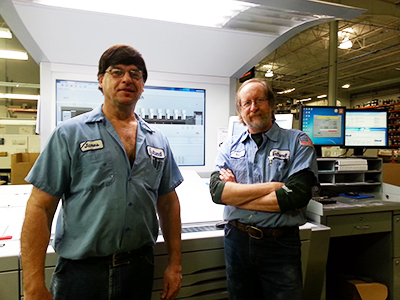Inland Label Benefits from Heidelberg Evaluation Program
- Published: February 27, 2013
KENNESAW, GA | The management team at Inland Label rarely misses an opportunity to give its employees the tools they need to continue to improve. The LaCrosse, WI-based custom label printing company, which currently operates three generations of Heidelberg’s flagship Speedmaster XL 105, saw in Heidelberg’s Operator Evaluation program the ideal vehicle to help raise its operators’ skills by assessing their knowledge of the XL platform and following up with targeted training as needed.
“We had a simple objective in undertaking the process,” said Inland’s VP of Operations Guy Billing: “Making our operators even better than they already were.”

Measuring Success
When low productivity cannot be traced to under-performing equipment or process flaws, Heidelberg’s Operator Evaluation skills-measuring program often can pinpoint a lack of operator knowledge in critical areas and chart a course for improvement.
Inland Label, which frequently collaborates with Heidelberg to accomplish its production goals, already boasts a long track record of instituting internal measures designed to ensure its operators’ skills are up-to-date. Two years ago, for example, the company put in place a very successful homegrown certification program for its sheetfed and gravure operators.
“Today’s manufacturing environment is vastly different from what it used to be, demanding a technologically sophisticated skillset few job applicants possess,” Billing said. “Consequently, as we have engaged with standardization and process control, it has become second nature for us to focus on operator training. What we have been missing are the metrics that would enable us to capture the results. Heidelberg’s Operator Evaluation testing supplies us with a helpful way to measure our success.”
Fears Allayed
Skills testing isn’t always the easiest thing to introduce in precision manufacturing environments like printing plants, where the link between job performance and job retention is obvious to everyone. For its part, Inland has positioned Heidelberg’s Operator Evaluation program as proof of management’s belief in the value of investing in the professional development of its employees.
“There was some fear and skepticism among our operators at first,” Billing acknowledged. “Some feared we were using the testing to get rid of poor performers, but all that fear went away when they realized that our goal was better and more targeted training.”
In developing the Operator Evaluation program, Heidelberg drew a distinction between equipment-specific training and an opportunity to test general knowledge across several categories. About 150 multiple-choice questions rate the test-taker’s practical understanding of general printing knowledge; basic color; color management; feeder; plate, blanket and impression cylinder; dampening and chemistry; inking; coating and anilox rollers; delivery and drying; symbols on control consoles; integrated Prinect Color Measurement devices. Online access via browser or mobile app makes the testing easy to take part in, and evaluations are customized to specific equipment setups.
Impact on the Bottom Line
Detailed post-test reporting links results to individualized Personal Evaluation Plans for all test-takers, giving recommendations for training needed to fill in knowledge gaps and help the operators reach their full potential. A related metric called Overall Equipment Effectiveness (OEE) shows owners how improved operator performance influences the parameters that drive bottom-line results.
Using the company’s own priorities as a guide, Heidelberg structured Inland Label’s Operator Evaluation test around general knowledge of the XL platform, with an emphasis on color theory and color measurement devices. All of the company’s operators took the same test. Test results subsequently showed “a universal weakness on the color side,” Billing said, “a finding that did not really surprise us, given the sophistication of the color tools available on the XL platform, as well as the fact that the company operates three generations of XL presses, each a little different from the others.”
After testing, Heidelberg helped Inland set up relevant training programs on site, including two days of classroom education in color science, followed by practical on-press training. While raising operator skills through assessment and training remains a sadly missed opportunity for many printers, Inland Label clearly understands that operator skills—like any other asset in a printing plant—are all about strengthening the bottom line through efficient production. The company has piloted four of its 16 press operators through the Operator Evaluation program thus far, and plans to put all of them through the process in due course. In partnership with Heidelberg, the company aims to keep its pressroom personnel—and the machines they run—performing at full potential.
According to Billing, his company plans to capitalize on the benefits of that partnership by certifying its operators on an annual or biannual basis. “It will be interesting to see how the program evolves from here,” he said.




